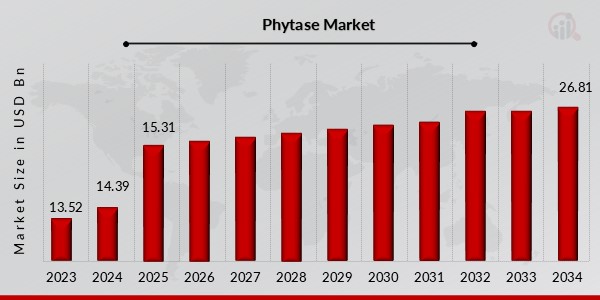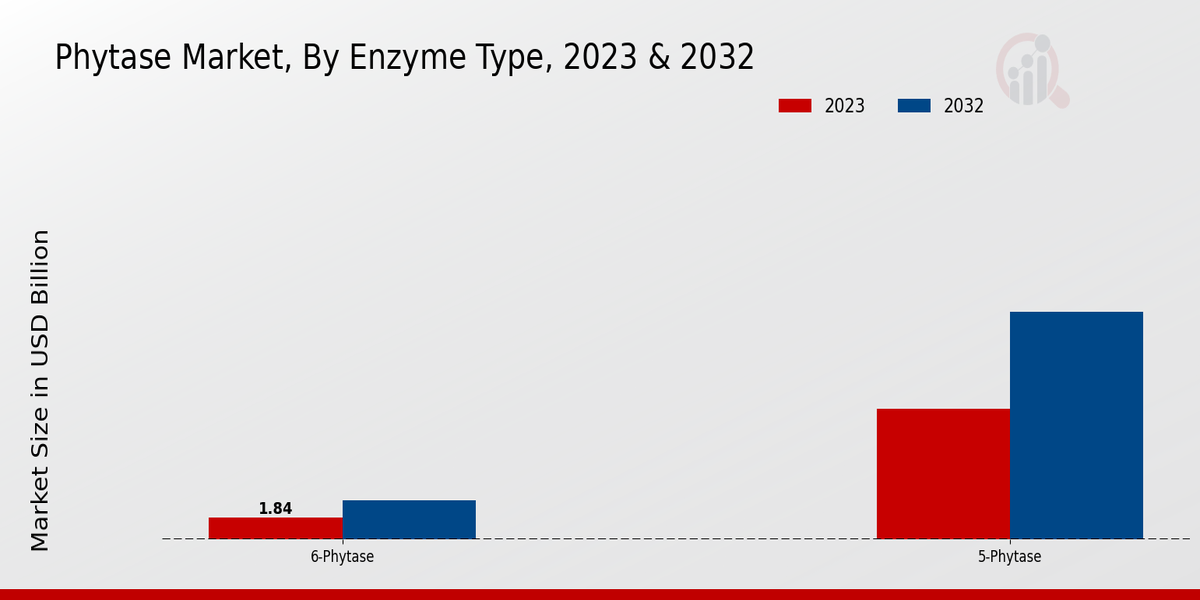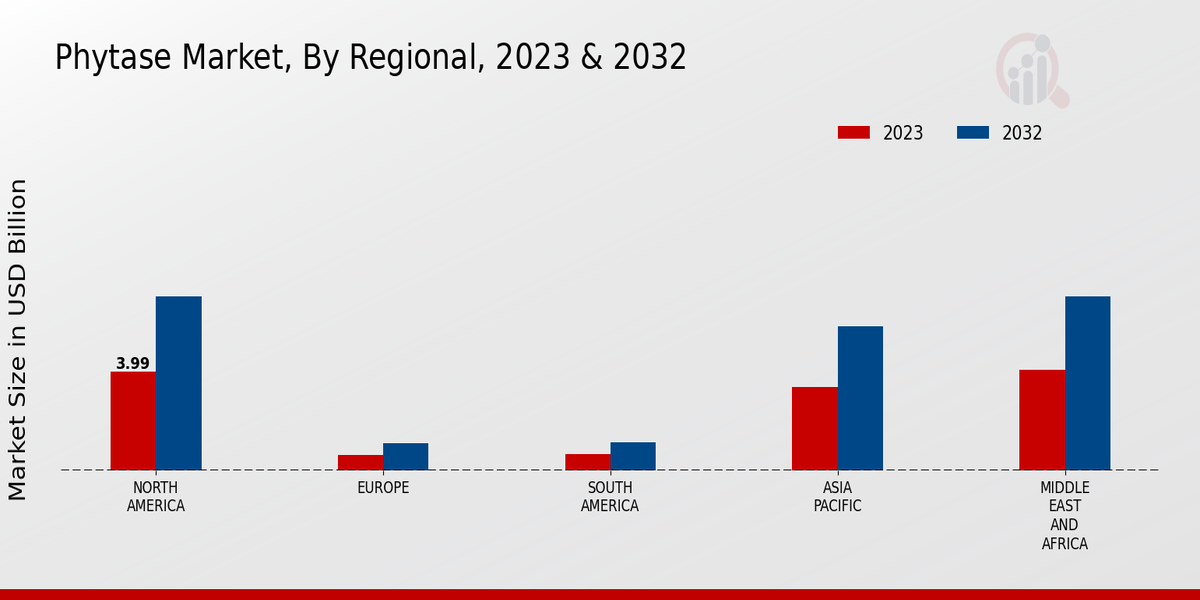Global Phytase Market Overview
Phytase Market Size was estimated at 14.39(USD Billion) in 2024. Industry is expected to grow from 15.31(USD Billion) in 2025 to 26.81(USD Billion) by 2034. The Phytase Market CAGR (growth rate) is expected to be around 6.4% during the forecast period (2025 - 2034).

Source Primary Research, Secondary Research, MRFR Database and Analyst Review
Key Phytase Market Trends Highlighted
The Phytase market is projected to experience significant growth driven by the increasing demand for animal proteins and the rising awareness of the environmental impact of phosphorus pollution. The need to improve feed efficiency and reduce production costs in livestock farming is also driving the adoption of phytase enzymes.
Opportunities in the market include the development of novel phytase enzymes with improved efficacy and stability, as well as the expansion of their applications in non-feed markets such as biofuels and wastewater treatment. Trends in recent times include the growing popularity of liquid phytase formulations and the increasing demand for phytase enzymes with multiple activities, such as xylanase and beta-glucanase activities.
To cater to the evolving needs of the market, key players are investing in research and development to enhance the efficiency and cost-effectiveness of phytase enzymes. The focus on sustainability and the demand for clean label products are also driving innovation in the Phytase market.
Phytase Market Drivers
Rising Demand for Animal Protein
The increasing population and rising disposable income are driving the demand for animal protein. This, in turn, is boosting the demand for phytase, as it helps improve the digestibility and utilization of phosphorus in animal feed. The growing awareness of the nutritional benefits of animal protein is also contributing to the market growth. Moreover, the increasing consumption of meat, poultry, and seafood is expected to further fuel the demand for phytase in the coming years.
Growing Adoption of Precision Feeding
Precision feeding involves tailoring the diet of animals to meet their specific nutritional requirements. This approach helps improve animal health and performance while reducing feed costs. Phytase plays a crucial role in precision feeding, as it helps optimize the utilization of phosphorus, which is an essential nutrient for animal growth and development. The growing adoption of precision feeding is expected to drive the demand for phytase in the coming years.
Increasing Demand for Sustainable Feed Ingredients
The growing awareness of the environmental impact of animal agriculture is driving the demand for sustainable feed ingredients. Phytase is a sustainable feed ingredient, as it helps reduce the excretion of phosphorus into the environment. This is because phytase improves the digestibility of phosphorus in animal feed, which reduces the amount of phosphorus that is excreted in manure. The increasing demand for sustainable feed ingredients is expected to drive the demand for phytase in the coming years.
Phytase Market Segment Insights
Phytase Market Enzyme Type Insights
The enzyme type segment of the Phytase Market is bifurcated into 6-Phytase and 5-Phytase. Among these, the 6-Phytase segment held a dominant market share in 2023 and is projected to continue its dominance throughout the forecast period. 6-Phytase is a phytase enzyme that is produced by microorganisms such as fungi and bacteria. It is used in animal feed to improve the utilization of phosphorus from plant-based feed ingredients. 6-Phytase breaks down the phytate present in plant-based feed ingredients, releasing phosphorus and making it available for absorption by the animal.This helps in reducing the need for inorganic phosphorus supplements in animal feed and also improves the overall performance and health of the animals. The 5-Phytase segment, on the other hand, is expected to witness a steady growth rate during the forecast period. 5-Phytase is a phytase enzyme that is produced by some bacteria and fungi. It is used in animal feed to improve the utilization of phosphorus from plant-based feed ingredients, similar to 6-Phytase. The growth of the market is attributed to the increasing demand for animal protein, the need for efficient utilization of phosphorus in animal feed, and the growing awareness of the benefits of using phytases in animal feed.

Source Primary Research, Secondary Research, MRFR Database and Analyst Review
Phytase Market Application Insights
The Phytase Market segmentation by Application is classified into Animal Feed, Food Industry, and Pet Food. Among these, the Animal Feed segment is estimated to hold the largest market share in 2023 and is projected to continue its dominance throughout the forecast period. The growth of this segment can be attributed to the increasing demand for animal feed additives to improve the nutritional value of feed and enhance animal performance. The Food Industry segment is also expected to witness significant growth due to the rising demand for phytase in food processing applications such as bread making, meat processing, and dairy production.The Pet Food segment is expected to grow steadily during the forecast period, driven by the increasing adoption of pets and the growing awareness of pet health and nutrition.
Phytase Market Source Insights
The source segment plays a crucial role in the Phytase Market revenue. Microbial sources held the largest market share in 2023, accounting for over 65% of the market. This dominance can be attributed to the widespread availability of microbial strains, their high production efficiency, and cost-effectiveness. Plant sources are expected to register a significant market growth rate over the forecast period, owing to the growing consumer preference for natural and organic ingredients in animal feed. Animal sources are projected to hold a smaller market share, limited by concerns over animal disease transmission and ethical considerations.The Phytase Market segmentation data indicates that microbial sources are likely to remain dominant, while plant and animal sources gain traction in niche applications.
Phytase Market Regional Insights
The Phytase Market segmentation by region offers valuable insights into the market's geographical distribution and growth dynamics. North America, Europe, APAC, South America, and MEA are the key regions analyzed in this report. North America holds a dominant position in the Phytase Market, primarily due to the presence of established animal feed industries and technological advancements. In 2023, North America accounted for approximately 38% of the Phytase Market revenue. Europe follows North America as the second-largest market for Phytase, driven by stringent regulations on animal feed quality and a growing demand for sustainable feed solutions.The APAC region is poised for significant growth in the coming years, owing to the increasing livestock production and expanding feed industry in countries like China and India. South America and MEA are expected to contribute a notable share to the Phytase Market growth, supported by the rising demand for animal protein and the implementation of modern farming practices.

Source Primary Research, Secondary Research, MRFR Database and Analyst Review
Phytase Market Key Players And Competitive Insights
Major players in the Phytase Market industry are constantly engaging in strategic partnerships, acquisitions, and collaborations to strengthen their market position. Leading Phytase Market players are investing heavily in research and development to introduce innovative products and expand their product portfolios. The Phytase Market industry is highly competitive, with key players focusing on developing cost-effective and high-performance products. Mergers and acquisitions are also prevalent as companies seek to consolidate their market share and gain access to new technologies and markets.One of the prominent competitors in the Phytase Market is BASF. The company has a strong presence and offers a wide range of phytase products. BASF is focused on developing sustainable and innovative solutions for the animal feed industry. Another key player in the Phytase Market is DuPont. The company offers a portfolio of phytase products under the brand name Danisco Animal Nutrition. DuPont is committed to providing high-quality products and technical support to its customers.Another major competitor in the Phytase Market is DSM. The company offers a range of phytase products under the brand name Ronozyme. DSM is known for its expertise in enzyme technology and its commitment to providing innovative solutions for the animal feed industry. The Phytase Market is expected to witness continued growth in the coming years, driven by increasing demand for sustainable and cost-effective feed solutions.
Key Companies in the Phytase Market Include
- Ralco Nutrition
- DuPont
- AB Enzymes
- Hansen Holding
- Danisco Animal Nutrition
- Huvepharma
- JBS S.A.
- Tate Lyle
- Novozymes
- Adisseo France
- BASF
- DSM
- Lallemand
- BIOCAT
- Kemin Industries
Phytase Market Industry Developments
The phytase market is projected to reach USD 22.2 billion by 2032, exhibiting a CAGR of 6.4% during the forecast period. Rising demand for animal protein, coupled with increasing awareness about animal welfare and sustainability, is driving market growth. Technological advancements and product innovations, such as the development of thermostable phytases, are further contributing to market expansion. Key industry players are investing in research and development to enhance product efficacy and expand their product portfolios. Strategic collaborations and acquisitions are also prevalent in the market, as companies seek to gain competitive advantage and expand their footprint. Recent news developments include the launch of new phytase products by leading manufacturers and the expansion of production capacities to meet growing demand.
Phytase Market Segmentation Insights
- Phytase Market Enzyme Type Outlook
- Phytase Market Application Outlook
- Animal Feed
- Food Industry
- Pet Food
- Phytase Market Source Outlook
- Phytase Market Regional Outlook
- North America
- Europe
- South America
- Asia Pacific
- Middle East and Africa
| Report Attribute/Metric |
Details |
| Market Size 2024 |
14.39 (USD Billion) |
| Market Size 2025 |
15.31 (USD Billion) |
| Market Size 2034 |
26.81 (USD Billion) |
| Compound Annual Growth Rate (CAGR) |
6.4% (2025 - 2034) |
| Report Coverage |
Revenue Forecast, Competitive Landscape, Growth Factors, and Trends |
| Base Year |
2023 |
| Market Forecast Period |
2025 - 2034 |
| Historical Data |
2019 - 2023 |
| Market Forecast Units |
USD Billion |
| Key Companies Profiled |
Ralco Nutrition, DuPont, AB Enzymes, Chr. Hansen Holding, Danisco Animal Nutrition, Huvepharma, JBS S.A., Tate Lyle, Novozymes, Adisseo France, BASF, DSM, Lallemand, BIOCAT, Kemin Industries |
| Segments Covered |
Enzyme Type, Application, Source, Regional |
| Key Market Opportunities |
1 Growing demand for animal feed2 Increasing awareness of animal health3 Rising meat consumption4 Expansion of the aquaculture industry5 Development of new phytase technologies |
| Key Market Dynamics |
Feed industry growth Rising awareness of animal welfare Technological advancements Increased demand for sustainable feed solutions Expansion of the aquaculture and poultry sectors |
| Countries Covered |
North America, Europe, APAC, South America, MEA |
Frequently Asked Questions (FAQ) :
The phytase market was valued at approximately USD 14.39 billion in 2024 and is expected to reach approximately USD 26.81 billion by 2034, growing at a CAGR of around 6.4% during the forecast period.
North America and Europe are expected to hold significant market shares in the phytase market due to increasing awareness about animal nutrition and feed efficiency, strict regulations regarding animal feed, and the presence of major market players in these regions.
The poultry segment is expected to dominate the phytase market throughout the forecast period. This is primarily attributed to the rising demand for poultry products, the growing adoption of phytase enzymes in poultry feed to improve phosphorus utilization, and the increasing focus on animal welfare.
Key players in the phytase market include BASF SE, DSM, Danisco Animal Nutrition, AB Enzymes, and Novozymes. These companies hold a significant market share and are continuously investing in research and development to enhance their product offerings and expand their geographical presence.
The rising demand for animal protein, increasing awareness about animal nutrition and feed efficiency, stringent regulations related to phosphorus discharge in animal manure, and the growing trend towards sustainable farming practices are driving the growth of the phytase market.
The availability of alternative phosphorus sources, such as inorganic phosphates, price fluctuations of raw materials, and stringent regulatory requirements in some regions pose challenges to the growth of the phytase market.
Advancements in biotechnology and genetic engineering are expected to lead to the development of more efficient and cost-effective phytase enzymes. Additionally, increasing demand for organic and sustainable animal feed products is anticipated to drive the growth of the phytase market in the coming years.
Yes, the phytase market is expected to witness significant growth in emerging economies, such as China, India, and Brazil. Rising awareness about animal nutrition, increasing consumption of animal protein, and government initiatives to promote sustainable farming practices are driving the demand for phytase in these regions.
Phytase has potential applications in various industries, including the food, beverage, and pharmaceutical sectors. It is used in food processing to improve the nutritional value of plant-based foods and in the production of functional foods. Additionally, phytase is being explored for its potential role in bioremediation and environmental applications.
Regulatory bodies play a crucial role in ensuring the safety and efficacy of phytase products. Stringent regulations regarding the use of feed additives, such as phytase, vary across different countries and regions. Manufacturers must comply with these regulations to ensure the safe and responsible use of phytase in animal feed.

















